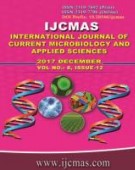


 National Academy of Agricultural Sciences (NAAS)
National Academy of Agricultural Sciences (NAAS)

|
PRINT ISSN : 2319-7692
Online ISSN : 2319-7706 Issues : 12 per year Publisher : Excellent Publishers Email : editorijcmas@gmail.com / submit@ijcmas.com Editor-in-chief: Dr.M.Prakash Index Copernicus ICV 2018: 95.39 NAAS RATING 2020: 5.38 |
A field experiment was conducted during kharif season of 2014 at Dr. N. E. Borlaug Crop Research Centre of G. B. Pant University of Agriculture and Technology Pantnagar, District Udham Singh Nagar (Uttarakhand) to evaluate the effect of different chemical and non-chemical methods of weed control on nutrient uptake by weeds and aerobic rice and impact of various weed control treatments on rhizospheric soil microorganism viz. bacteria, fungi and actinomycetes. Lowest uptake of nitrogen by weeds was found in plots treated with pendimethalin (30 EC) @ 1.25 kg/ha fb one HW followed by weed free while lowest uptake of phosphorous and potassium by weeds were recorded in weed free plots followed by pendimethalin (30 EC) @ 1.25 kg/ha fb one HW. Highest uptake of nitrogen, phosphorous and potassium by crop was recorded in plots treated with by pendimethalin (30 EC) @ 1.25 kg/ha fb one HW. Highest population of bacteria was recorded under weedy check followed by weed free and wheat straw mulch (4 t/ha) fb one HW. Maximum fungal population was recorded in Sesbania co-culture fb pendimethalin (30 EC) @ 1.25 kg/ha fb 2, 4- D (38 EC) @ 0.5 kg/ha while maximum population of actinomycetes was recorded in wheat straw mulch (4t/ha) fb one HW.
 |
 |
 |
 |
 |